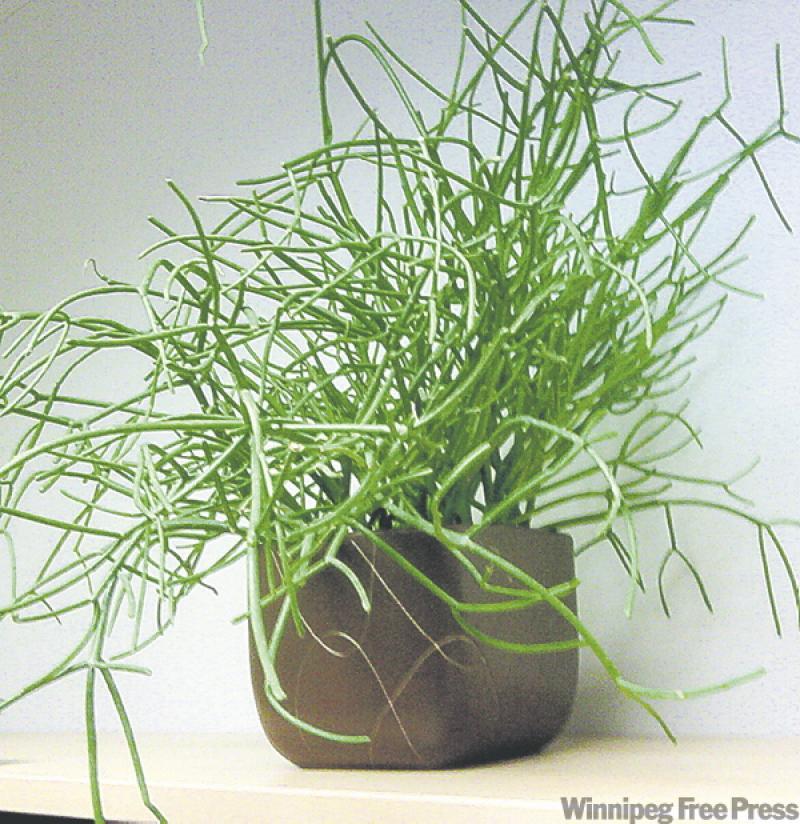
I was wondering if you could tell me what the plant in the attached picture is. It was given to me and everyone who comes into my office marvels at it and asks me what it is. I haven't a clue! Also, do you know where I could purchase more to give as gifts?
-- Kim
ANSWER: Without conducting a DNA test my best educated guess is your plant is probably a succulent in the genus Euphorbia brachiata or the bigger E. tirucalli commonly called Pencil Cactus or Milk Cactus. In Tanzania it is supposedly used to cure sexual impotence and as a mosquito repellent. Its sap is toxic -- be sure never to get any sap near your eyes. One on-line greenhouse maintains it is one of the best succulents for a houseplant in a sunny window as it can grow into a magnificent plant of considerable dimensions over the years, with spineless, beautiful, much-divided slim pencil branches creating a compact, woody thicket. In Ohio, U.S. Glasshouse Works offers these plants in their on-line mail order catalogue. Their contact info is www.glasshouseworks.com/onlinecatalog.html and they may ship small plants to Canada.
I don't know where you can get some locally. Why not try propagating your own by taking a few cuttings? Carefully remove the first four to six inches of a terminal shoot and after letting the wound heal over, insert in a moist, sandy mix. (Much like you would handle a common jade plant cutting.) With time and patience the cutting should form roots at which time you can pot it up and pass it on.
QUESTION: I made my first attempt at a predominately perennial bed this spring and for the most part it is coming along. One of the exceptions is a white peony plant that had four stems and was approximately eight inches high when I planted it six weeks ago. Since then it has done zip and looks exactly the way it looked on day one. What gives? Did I get sold some form of Japanese miniatures, or is patience a virtue when it comes to peonies? Your advice appreciated. (The bed faces west.)
Overgrowth problem: My Tomato plants look healthy and are approximately four inches high. However the largest tomatoes are just over golf ball size so far. Although they are nicely branched with healthy leaves, they have not gone wild as I stake and prune them. I read about someone on the net promoting a book or catalogue on tomatoes where his philosophy had to do with a radical removal of most of the branches to promote larger fruit. It seemed to hinge on retaining either the branch immediately above or below the fruit stems. Have you ever heard of this? I'm reluctant to dismiss his tried-and-true method, but I didn't feel like sending the $19.95 to find out, especially if you know the answer. I water regularly, and have been using 15-30-15 every 10 days with the odd 10-60-10 feeding. I would like your comments.
-- Thanks, Jim
P.S. The varieties are Big Beef, Fantastic, & Sweet Cluster
ANSWER: Save your $19.95 unless it will buy us some better weather. The problem with your tomatoes is a lack of heat and sunshine so far this year. It sounds like you are doing everything else correctly. The type of pruning that is usually done on tomatoes is the removal of all non-fruitbearing suckers to direct the plant's energies to fruit production.
As for the peony, yes patience is indeed a virtue in most cases when it comes to newly planted perennials. There is an old garden adage regarding perennials that says "the first year they sleep, the second year they creep and the third year they leap." Peonies are one of those enduring prairie plants that just need to set down some good roots the first year in the ground.
QUESTION: I read with interest and admiration the column about the beautiful balcony garden. As I struggle with the wind and other problems, I must say I can't believe her success. I have moved some plants closer to the windows so I will see what happens. I find my most success so far is with New Guinea impatiens and cacti. On two bush tomato plants, I have one tomato on each.
My question is about the screening used on the O'Neil balcony. It looks like chicken wire but with something solid in between. I would be most interested in knowing what it is, as it looks attractive and hopefully would serve as a shield against the wind.
-- Bonnie
ANSWER: The fine screening appears to be builder's mesh, which is a fine wire product applied to the outside of walls before stuccoing. It is attached to the permanent balcony railings.
QUESTION: I have some questions to ask about perennials. I have two flower beds up against the front of my house which faces north west. I don't seem to have much luck getting perennials to survive more than one or two years.
Also I'm not sure what to do to perennials in the fall. Are you supposed to cut them back? Should they be covered with anything for the winter?
-- Thank you. Amanda
ANSWER: You've raised many questions regarding your lack of success growing perennials. A northwestern exposure lacks direct sunlight and the perennials you choose to plant there should be tolerant of shade.
Each specimen has its own set of cultural requirements. Some need sunny, dry conditions, others dark, wet sites. Have you improved your soil with compost and do you water regularly? Flower beds butting up against the house are notorious for being too dry without extra irrigation.
Choose a combination of hardy perennials for the shade such as hosta, native fern, ajuga, Solomon's seal, tiarella, huechera, aruncus, pulmonaria, astilbe, lamium, viola or ligularia (to name a few). Pamper them a bit in the first year and they should return bigger and better every spring.
You can trim the plants back in the fall or let the plants die back naturally, then apply a few inches of mulch for extra winter protection. But really, all the protection they need is a good insulating snow cover. You can do a cleanup in the spring when new growth emerges.
linda.stilkowski@freepress.mb.ca



